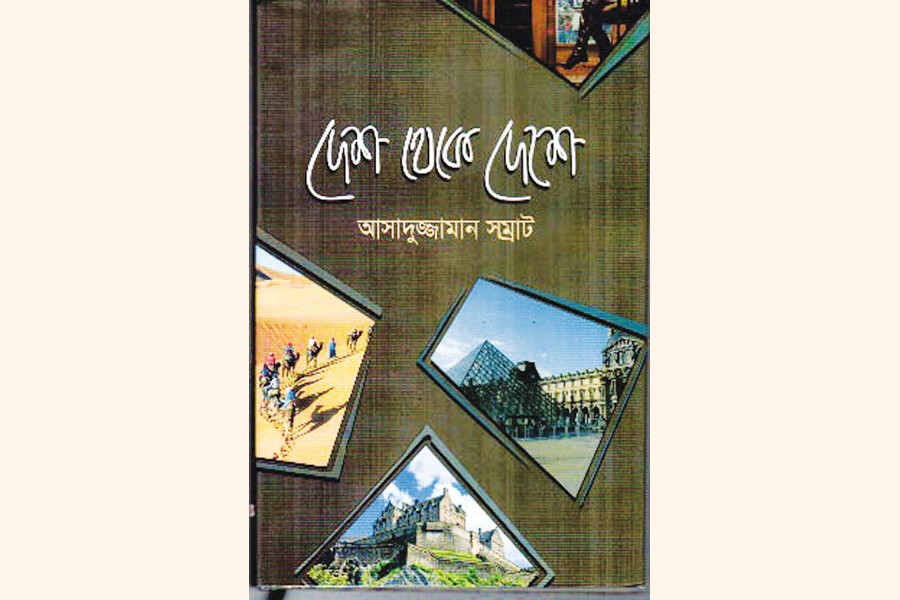
Published :
Updated :

 In Desh Theykey Deshey (Across Countries), journalist and author Asaduzzaman Shamrat writes about Louvre Museum, its rich collection on display and about Monalisa.
In Desh Theykey Deshey (Across Countries), journalist and author Asaduzzaman Shamrat writes about Louvre Museum, its rich collection on display and about Monalisa.
He writes that he saw it all in 2015, during his visit to Paris to cover the 21st UN Framework Convention on Climate Change better known as COP-21 where an agreement was signed by participating countries for reducing global warming.
He says that the book is not a conventional travel story but that it's about information and recreation.
The newspaper for which he works had sent him to cover the conference. He spent much of his time to see the Bastille Fort with his friends based in Paris.
The Louvre Museum stands on a 15-acre area. 'It has an art gallery.' 'The Louvre, built during the reign of St Louis, is a witness to history. It cannot be called a palace as it housed a full garrison. 'In 1546, King First Francis began using it as a palace. In 1642, Louise the 14th, vacated the Louvre for use as a museum and began to reside in Versaille.
During Napoleon's time the collection was increased enormously with the artefacts looted by soldiers.
The Louvre's journey began as a museum with 537 artefacts.
After the defeat of Napoleon in 1815, France returned many of the artefacts to their owners. The Egyptian and many other sections in the Louvre got into the Louvre following Napoleon's invasions.
Pyramid was opened to visitors in 1988.
Though smallest of all the paintings on display in the Louvre, Monalisa remains the centre of attraction to the visitors from all over the world.
Asaduzzaman provides a pen picture of his visit to Casablanca to cover COP-22 held in the historic Moroccan city, surrounded by the Atlantic Mountain range.
The city is close to Sahara desert. From Casablanca he visited Morocco.
During the visit he saw the famous film "Casablanca", a habit he developed while working for 'Jai Jai Din' edited by Shafique Rehman.
During a two-day recess, the author with his friends took a 400-km tour from Marakkesh to Mehmid in Western Sahara along the dangerous and narrow road that cuts across the Atlas range.
He writes that he has no words to describe the thrilling experience of spending night in a tent on the Sahara about which he read in the textbook in his schooldays.
He also writes about his visit to see the 'Love Lock Bridge' and the iconic Eiffel Tower. He also visited Versaille, not so much to see the palace there, but to see the place where Michael Madhusudan Dutt lived in abject poverty, about which he read in his schooldays.
He also visited Versaille, not so much to see the palace there, but to see the place where Michael Madhusudan Dutt lived in abject poverty, about which he read in his schooldays.
In Versaille, Michael Madhusudan lived in two houses, pretty close to the palace and the other one far from it.
The name of the place, however, has been changed to Rue Des Chantiers, but the number of the house, 12, remains unchanged.
He gives an account of his visits to the Vatican City and the Colosseum.
He gives an account of his visit to Madrid to cover COP-25 and Amsterdam, his visits to Brussels, Louxembourg and Malaysia.
He gave a detailed account of his visit to Tajmahal with his wife and two sons.
The book deals with COP-26, dedicated to the people living along the Amazon and their concern over their life and losing livelihood.
Brick Lane is now a ghost lane, he writes.
He also writes about the spot where Diana died and how her death compelled the British Royal family to mourn her death breaking its stiff tradition.


 For all latest news, follow The Financial Express Google News channel.
For all latest news, follow The Financial Express Google News channel.